Program Spotlight: Introducing Our Innovation Division and Cultivating a Future-Focused Network Mindset
Main Street America is excited to introduce the Innovation Division and share some of our key focus areas and upcoming projects.

Marion, Iowa © Tasha Sams
We work in collaboration with thousands of local partners and grassroots leaders across the nation who share our commitment to advancing shared prosperity, creating resilient economies, and improving quality of life.

Emporia, Kansas © Emporia Main Street
Made up of small towns, mid-sized communities, and urban commercial districts, the thousands of organizations, individuals, volunteers, and local leaders that make up Main Street America™ represent the broad diversity that makes this country so unique.

Chicago, Illinois © Main Street America
Looking for strategies and tools to support you in your work? Delve into the Main Street Resource Center and explore a wide range of resources including our extensive Knowledge Hub, professional development opportunities, field service offerings, advocacy support, and more!

Waterloo, Iowa © Main Street Waterloo
Your one-stop-shop for all the latest stories, news, events, and opportunities – including grants and funding programs – across Main Street.

Kendall Whittier — Tulsa, Oklahoma © Kendall Whittier Main Street
Join us in our work to advance shared prosperity, create strong economies, and improve quality of life in downtowns and neighborhood commercial districts.
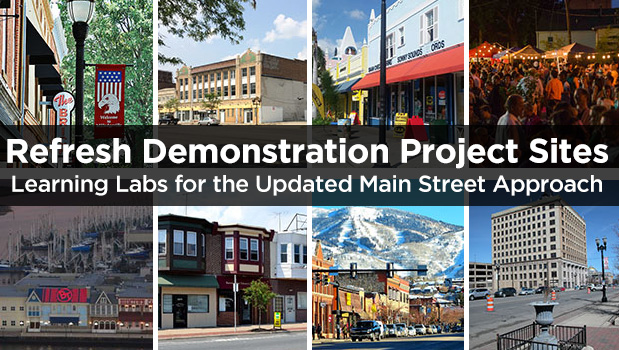
Earlier this fall, we announced the beta-launch of the “refreshed” Main Street Approach, characterized by a focus on inclusive engagement, district-level strategy, meaningful outcomes, and more flexible organizational structure. As part of this beta roll-out, the National Main Street Center is conducting a series of demonstration projects—in places with existing Main Street programs, as well as districts that don’t have a traditional Main Street structure in place—providing the opportunity to test some of our new strategies on the ground, learn from practitioners, and refine the approach. Over the course of the next year, we are excited to have the opportunity to work in Biloxi, Mississippi; Detroit, Michigan; Gary, Indiana; Lexington, Kentucky; Miami, Florida; Milledgeville, Georgia; Philadelphia, Pennsylvania; as well as Brush!, Lake City and Steamboat Springs, Colorado.
Thanks to the John S. and James L. Knight Foundation and the National Trust for Historic Preservation for funding work in seven of the ten initial demonstration projects in Knight Cities across the county, and to the Colorado Department of Local Affairs for their partnership and support of the work in Colorado.
Over the course of the next year, these demonstration project sites will serve as learning labs as local revitalization practitioners and representatives from NMSC and the Community Land Use and Economics Group will work together to articulate a set of transformation strategies, refine community engagement techniques, and generate meaningful success indicators by which to measure progress. We will provide you with regular updates from the field so that you can learn along with us, but in the meantime, we want to briefly introduce you to the group of ten demonstration project sites.
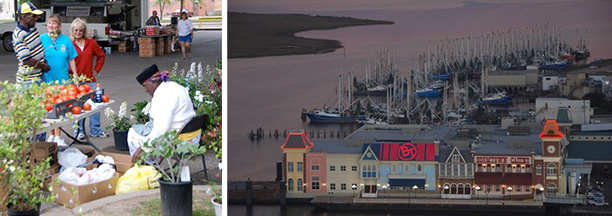
Photo: Mississippi Main Street
Local Partners: Biloxi Main Street, lead partner; other partners: Mississippi Main Street Association, City of Biloxi
District Background: Ten years ago, on the morning of August 29, 2005, Hurricane Katrina drastically changed to fate of many communities, and countless lives, along the Gulf Coast. The historic downtown district of Biloxi, Mississippi, felt the economic, social, and physical destruction of the storm keenly, including the loss of 50 buildings (mostly historic) and many small “mom and pop” style businesses within the Main Street district. While the casinos and larger, tourism-related businesses were able to bounce back within the first five years, Biloxi’s downtown is just now seeing a resurgence of those arts-based, independent, seaside related businesses that really gave the town its special flavor.
The Biloxi Main Street program—which was founded in 1989—has been leading the charge to bring life and vitality back to the historic core.
Challenges and Opportunities: The future of Biloxi’s Main Street district is wide open. While the dominance of the casino industry and car-centric infrastructure pose some challenges, the city is benefiting from the energy and commitment of a new mayoral administration that truly supports downtown revitalization and a growing tourism economy along the Mississippi Gulf Coast.
The Main Street project team will be working with local Main Street leaders, as well as the statewide Mississippi Main Street Association, to develop strategies to enhance the emerging arts scene, and small business environment. This demonstration project will also provide us with an opportunity to better understand how the “refreshed” Main Street Approach fits with a traditional Main Street organizational structure.
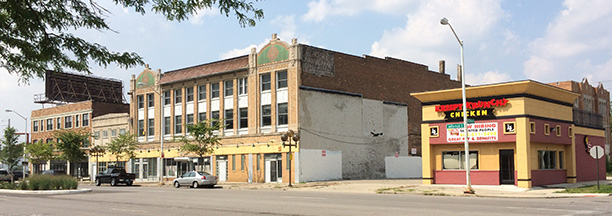
Photo: Jefferson East, Inc.
Local Partner: Jefferson East, Inc.
District Background: The Jefferson-Chalmers neighborhood of Detroit was originally developed in the early 20th century as part of the Village of Fairview. The commercial district served as the core of the vibrant neighborhood from the 1910s to 30s, with a particular boom through the 1920s as numerous automotive manufactures set up shop. But as the automotive industry declined in the 1950s, so did Jefferson-Chalmers. The area was declared an urban renewal district in the 1960s and the racial divisions that had developed with traditional Detroit patterns of segregation within the neighborhoods began to ease.
Challenges and Opportunities: Today Jefferson-Chalmers contains the largest surviving collection of neighborhood commercial historic structures within the city of Detroit. The district was listed on the National Register of Historic Places in 2003, at which time it had 57 structures, 40 of them contributing. While the district benefits from this rich building stock, it suffers from a surplus of commercial space, leading to a relatively high vacancy rate, dropping rents, and significant disparity in terms of curb appeal among occupied buildings.
The Main Street project team will be working leadership from Jefferson East to refine a set of Catalyst Strategies aimed at maximizing Jefferson Chalmers’ position as an entertainment and convenience goods and services district.
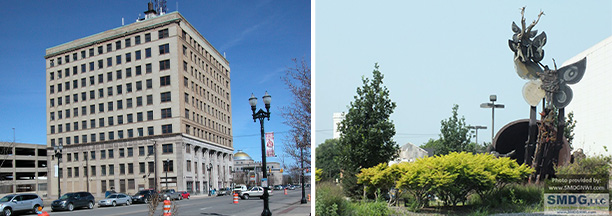
Photos: Arsh Group, Inc; SMDG, LLC
Local Partners: City of Gary, Department of Commerce, lead partner; other partners include: Legacy Foundation, Gary Public Transportation Corporation
District Background: Like many legacy cities that were largely dependent on a single industry, Gary has experienced steep declines in its population—as well as in the numbers of jobs and businesses—over a period of more than forty years. The story of Gary’s rise and subsequent decline is a familiar one, repeated in many Rust Belt cities across the Midwest. In its heyday, Gary was a thriving steel town, home to a diverse population of factory workers, families, and business owners. However, since the 1960s the population has been in steady decline, and most large employers have left town, forcing downtown Gary to face the struggles of urban disinvestment, under-population, deteriorating infrastructure, and high vacancy rates.
Challenges and Opportunities: Other than population and job declines, Gary has not changed much over the past ten years, but with the 2011 election of Mayor Karen Freeman-Wilson, there is renewed momentum in turning things around.
In 2013, Gary was named one of seven new Strong Cities/Strong Communities (SC2) by the Obama Administration, bringing resources and technical assistance from almost thirty Federal agencies to the city. Among the most prominent are the Environmental Protection Agency (EPA) and the Department of Housing and Urban Development (HUD)—both of which have assigned employees to work at City Hall, side by side with city staffers. These partnerships have been instrumental in helping the city identify targeted areas for revitalization, providing assistance with brownfields challenges, and coordinating funding streams to address some of the most critical challenges Gary is facing.
Recent revitalization efforts have focused on Gary’s neighborhoods—including the Miller Beach community, Emerson, and University Park-East. While there are signs of progress in these areas, to date no comprehensive efforts have been focused on downtown revitalization. Consequently, redevelopment is occurring randomly—an approach that makes it difficult to achieve the critical mass needed to spur that degree of high-density development that can produce sustainable results in the overall downtown area.
The local leaders at the City of Gary, in partnership with other nonprofit, private, and governmental partners, are seeking assistance from the Main Street team to approach downtown revitalization from a comprehensive perspective, leverage the redevelopment that is already occurring, and better plan and implement redevelopment from an historic preservation perspective.
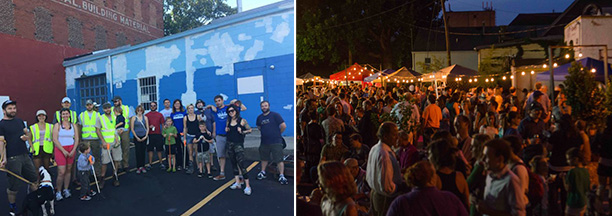
Photos: NoLi CDC
Local Partners: Lexington Downtown Development Authority, Bluegrass Community Foundation, NoLi CDC
District Background: Lexington has had its share of progress and success in the last ten years. However, prior to 2010, the city had not made key public infrastructure investments that exist now, such as new pedestrian friendly streetscape and an outdoor pavilion for hosting live events. There was no regulatory provision for outdoor dining, which resulted in a lack of commercial restaurant attraction and activity. The lack of event programming beyond concerts and games at Rupp Arena contributed to deserted streets and sidewalks after dusk. Historic buildings throughout the downtown were in a state of urban decay and there was a lack of commercial businesses to serve the needs of the surrounding neighborhoods. To further challenge the downtown dynamics, a comprehensive downtown parking strategy was absent.
Today, Lexington has a population of approximately 305,000 and is projected to grow by 5% over the next five years. Lexington has unique and favorable attributes for a mid-sized city as it home to not only the state's flagship campus, the University of Kentucky, but also benefits from a private university and supporting technical schools. The diverse local economy is supported by service, government, education and health care sectors. Lexington recovered much more quickly from the Great Recession than other mid-sized cities due to this diversity and much of the current economic investment occurring in downtown Lexington is attributed to the $1.3 billion capital investment by the University of Kentucky over the past three years. In addition to the attributes of having the downtown framed within an educational triangle, the compact Central Business District is surrounded by neighborhoods that are very diverse architecturally, socially and economically.
Many downtown and surrounding neighborhoods have benefited from targeted planning studies in the past ten years, but not all of these plans have achieved implementation or investment. A 2400-acre area north of downtown known as the Central Sector had a Small Area Plan prepared in 2009. There are sporadic pockets of positive rehabilitation that have occurred in this area post-2009, but most investment in the historic building stock has occurred in an area referred to as the North Limestone (NoLi) neighborhood which has an active Community Development Corporation within the Central Sector area. Despite this encouraging investment, the broader Central Sector and adjoining East End neighborhood suffer from a disproportionate share of crime, abandoned properties and household incomes near the poverty level.
Challenges and Opportunities: The Main Street project team will work with two neighboring commercial districts in Lexington—the Central Sector (with the NoLi CDC leading the revitalization charge), and East End (with revitalization efforts led by the Bluegrass Community Foundation). Both the East End and Central Sector neighborhoods have seen improvements in community revitalization since the adoption of a 2009 Small Area Plan, but there is still much to be done to ensure that growth and revitalization are done in a way that is equitable and reflective of the needs and desires of local residents.

Photo: Matt Wagner, NMSC
Local Partner: Northeast Second Avenue Partnership (NE2P)
District Background: Little Haiti, the community that is the focus of N2AP’s revitalization efforts, is located in the heart of the City of Miami, less than ten miles from downtown. What was once a small farming community known for its lemon production, is now a bustling, vibrant urban corridor widely recognized as a hub of Haitian culture. In the 1980s and 90s, the area struggled with poverty, low-employment, and high vacancy rates. While some of these issues still affect the district today, Little Haiti, like many other areas of Miami, is undergoing significant change. Much of this change is exciting — bringing with it new investment, artists seeking studio space, and new opportunity for local residents —but there is also the real concern that this development will accelerate gentrification, potentially pricing local residents out of the community and distilling the local character that makes Little Haiti unique.
Challenges and Opportunities: In “hot” markets like Miami, there is constant tension between encouraging development and investment, and resisting the negative impacts of gentrification on local residents and long-time business owners. In Little Haiti, local leaders understand that change is inevitable—several adjacent neighborhoods, including Wynwood, the Design District, and Midtown are already on this path. The revitalization goals are based on the need to manage and guide the change in a way that benefits the entire community. Already a vibrant community, Little Haiti’s focus now is on becoming the ultimate authentic Haitian cultural experience. To that end, the Main Street team will work closely with NE2P to leverage local economic opportunity for residents, and guide the creation of a Haitian-influenced arts and entertainment district.
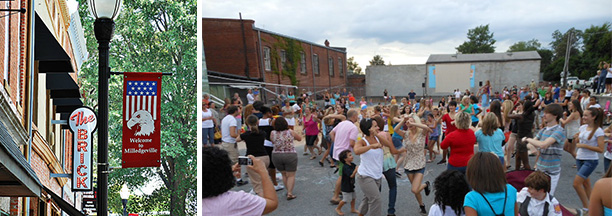
Photos: Milledgeville Main Street
Local Partners: City of Milledgeville Main Street
District Background: Downtown Milledgeville is a charming district nestled between Georgia Military College and Georgia College & State University. The area is a history buff’s paradise with an eclectic mix of activities; something for everyone. The buildings located in the historic central business district have been beautifully preserved and adaptively restored for businesses. Today, with a population of 19,256, the historic downtown is the pride of the city.
The current, diverse mix of old and new is a far cry from the drab downtown of the past. Ten years ago, there were few options for dining and shopping. Buildings sat vacant, several in disrepair, and the shift from the downtown area to strip malls was in full swing. The sidewalks and streetscape downtown had all but been forgotten and there were a limited number of residential units.
Since that time, there has been a resurgence of life put back into downtown. As part of the renaissance, the City of Milledgeville has completed four streetscape projects over the past decade, helping propel the downtown into a vibrant, thriving area. New sidewalks, street lights, hand rails, and even striping gave the area a much needed facelift. Through the use of social media, events, personal contact and economic development opportunities, the Main Street program keeps the momentum going. Today, downtown Milledgeville combines southern charm with vibrant energy, stemming from the college-town atmosphere, new loft apartments, events, specialty shops, and a number of unique hometown eateries, transforming it into a bustling community.
Challenges and Opportunities: While downtown Milledgeville is already a testament to the power of Main Street revitalization, there is still work to be done. Local leadership is eager to partner with the Main Street team to engage more deeply in community engagement, and create a plan to entice more college students to call Milledgeville home after graduation.

Photo: Tacony CDC
Local Partners: Tacony Community Development Corporation, lead partner; other partners include: Free Library of Philadelphia, the Philadelphia Department of Commerce, Mural Arts Program, and Councilman Bobby Henon
District Background: The Tacony Community Development Corporation is well-versed in the “language” of Main Street, but has also already naturally transitioned to a more strategy-focused way of doing business. By tapping into new technologies, forging broad partnerships, and convening volunteers around project-specific work groups, the local leadership in Tacony has established a strong organizational base that is well suited to support this district in transition.
Ten years ago, Tacony enjoyed a healthy housing market with a primarily aging white population of householders and families and a high level of homeownership. At that time, Tacony enjoyed a low vacancy rate along the main commercial corridor and fairly limited revitalization involvement by the City of Philadelphia. Expanding household incomes during the mid-2000s allowed new homeowners to purchase their very first home. Tacony’s location along I-95 and Regional Rail made it attractive to those who worked downtown and in surrounding counties.
Today, Tacony has become more diverse, and is still recovering from a deep housing recession and a slow-growing economy. Tacony has more families and an even greater population than it did ten years ago, but there are significant challenges. The foreclosure crisis hit Tacony especially hard, and while some houses are slowly being sold and rehabbed, many vacant properties still remain off the market accumulating deferred maintenance. Many commercial properties purchased pre-recession by out-of-state investors are now worth 50% of what their investors paid during the bubble and sit vacant. Even in light of these specific challenges, Torresdale Avenue—the main commercial corridor in the district—has achieved significant progress over the past three years with the effective vacancy rate falling from 30% to less than 10%. New business owners along Torresdale Avenue include many immigrants speaking many different languages. While diversity has brought new energy and new excitement it has also brought new challenges as well as cultural barriers to participation in an overall revitalization effort.
Challenges and Opportunities: With a strong network of organizational partners, including the Free Library of Philadelphia, the Philadelphia Department of Commerce, Mural Arts Program, and Councilman Bobby Henon, the Tacony CDC is poised to build on its past successes, and pave the way for a vibrant and growing community with residents who take pride in their community, historic homes that are well maintained, and highly engaged business owners—with Torresdale Avenue at the center of it all.
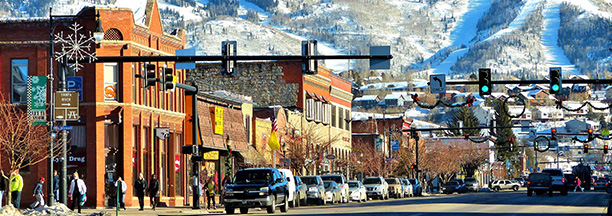
Photo: Steamboat Springs, Shannon Lukens
Local Partners: Colorado Department of Local Affairs/Colorado Main Street, Brush Area Chamber of Commerce, Lake City DIRT, Main Street Steamboat Springs
Background: Brush!, Lake City, and Steamboat Springs are three of Colorado’s highest performing Main Street Programs. Each of these rural communities benefit from great historic building stock, strong local character, and scenic locales that attract seasonal visitors. For each, the downtown is the heart of the community—designed on a pedestrian scale, supportive of local businesses, and inviting for visitors and residents.
Brush! is a vibrant rural community in Morgan County —an area of the state that is enjoying steady growth and economic development. Like many towns out west, Brush! began as a small industry town, attracting ranchers and farmers traveling west on the railroad in the mid-19th century. Today, the town retains a strong historic feel, and still has a steady agriculture-based economy. With recent improvements to the streetscape, six registered historic landmarks, and a growing population, Brush! is well poised to build on its momentum in the coming years.
Lake City, like Brush!, experienced a period of significant growth and prosperity in the 19th century with the development of rail routes through the area and a booming mining industry. Throughout the 20th century, a solid tourist industry contributed to the local economy, and local residents helped to restore many of the historic buildings in the downtown, spurring local economic development. Today, this small town (population is under 500) is a prime example of how rural communities can leverage their distinctive assets to grow their economies.
With breathtaking views of the mountains, a beautiful historic commercial core, and strong sense of tradition, Steamboat Springs is both a tourist’s delight and a great place to call home. Main Street Steamboat Springs spearheads the effort to keep downtown healthy and vibrant—engaging volunteers and local leadership to preserve its historic assets, promote the businesses and events that take place downtown, and to advocate for enhancement of the downtown in the face of other developments threatening to draw business away from the center of the community.
Challenges and Opportunities: These graduate communities have demonstrated long-term positive stewardship, fiscal responsibility and community support for their respective programs. Each has demonstrated significant success in implementing the Main Street Approach, and already begun to transition to a “project-based” organizational approach, as opposed to a strict Four-Point committee structure. The Main Street project team will work with the statewide Coordinating Program and local leadership to help integrate the “refreshed” approach, improving the economic vitality and long-term sustainability of each of these three Colorado towns.